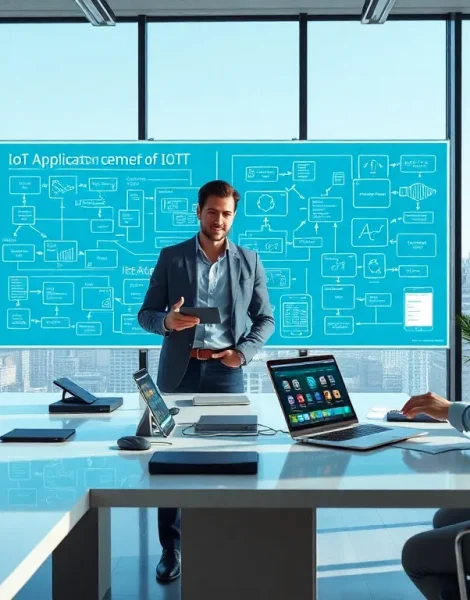The Internet of Things (IoT) is more than just a buzzword: it’s a revolution that’s already changing how we live and work. Imagine walking into your house and telling your smart fridge to order groceries while your thermostat adjusts to your favorite temperature. Sounds like science fiction, right? But this is the reality that IoT software development is bringing to life. Whether you’re a tech enthusiast or just curious about how these devices communicate, this article will unpack the complexities and excitement of IoT software development in a way that’s insightful yet easy to grasp.
Table of Contents
ToggleUnderstanding The Internet Of Things

The Internet of Things refers to a vast network of physical devices connected to the internet, sharing data and responding to interactions. From smart home gadgets to industrial machinery, IoT impacts almost every aspect of daily life. This technology enables devices to gather and exchange data, creating an ecosystem where everything is interconnected. A good example is smartwatches that monitor health metrics and send alerts to users.
IoT’s Impact on Everyday Life
Two decades ago, if someone had mentioned that your refrigerator could remind you to buy milk, you might have laughed. Today, IoT devices seamlessly integrate into our lives, often without us even realizing it. Statista estimates that there will be over 75 billion connected devices by 2025. This boom drives innovation, changing industries from healthcare to agriculture.
The Role of Software in IoT
But it’s the software behind these devices that brings them to life. IoT software development focuses on creating applications that allow devices to communicate with each other, harnessing data and making it actionable. Without robust software, connectivity remains an unfulfilled promise.
Key Components of IoT Software Development
When diving into IoT software development, several key components come into play:
- Hardware: This includes sensors, processors, and connectivity modules. Every IoT device starts with hardware capable of collecting data.
- Connectivity: This is how devices communicate. Various protocols exist, such as Wi-Fi, Bluetooth, and cellular networks. Each serves a unique purpose depending on range and speed requirements.
- Data Processing: This component involves collecting, analyzing, and transforming raw data into meaningful insights. Cloud computing platforms often store and process this data, enabling real-time decision-making.
- User Interface: Whether on a smartphone app or a web portal, the user interface needs to be intuitive. Users should easily understand how to interact with their devices, and software developers must prioritize user experience (UX).
- Security: As more devices become interconnected, the risks associated with data breaches grow. IoT software development must incorporate security measures at all stages, from design to implementation.
IoT Application Development Process
Developing IoT applications is a complex process that typically involves several phases:
1. Requirement Analysis
Initially, a clear understanding of client needs and project scope is essential. This phase may include discussions to outline project specifics, what the device will do, the type of data it will collect, and how it will interact with other devices.
2. Prototype Development
Creating a minimum viable product (MVP) allows developers to gather feedback early in the process. This prototype doesn’t need to be perfect but should include key functionalities that demonstrate the concept.
3. Testing and Iteration
Once the prototype is in place, rigorous testing follows. This stage evaluates performance, identifies bugs, and ensures that the product integrates well with other systems. Developers usually engage in several iterations, refining the software based on feedback and testing results.
4. Deployment and Maintenance
After final testing, the application can be deployed. Continuous monitoring and maintenance are crucial, as new updates or functionalities may be needed over time.
Challenges in IoT Software Development
While the potential of IoT software development is immense, it does come with its share of challenges:
1. Connectivity Issues
Ensuring stable connectivity is a constant challenge for many IoT applications. Various factors can disrupt communication, leading to unreliable performance.
2. Data Management
IoT generates massive amounts of data. Storing, processing, and ensuring data quality can overwhelm existing systems, necessitating advanced data management solutions.
3. Security Concerns
As mentioned earlier, security remains a critical concern. Developers face the challenging job of safeguarding sensitive data from potential breaches, a responsibility that requires sophisticated approaches.
4. Standardization
With numerous devices and protocols available, a lack of standardization can hinder interoperability among devices. This challenge complicates integration across systems.
Future Trends in IoT Software Development
The landscape of IoT software development is continually evolving. Here are some trends to keep an eye on:
1. Edge Computing
As IoT devices proliferate, edge computing allows data processing closer to the source rather than relying on distant cloud servers. This reduces latency, making applications more efficient.
2. Enhanced AI Integration
Artificial intelligence (AI) is increasingly becoming a part of IoT solutions. From predictive analytics to real-time decision-making, AI enhances the functionality of IoT devices, creating smarter applications.
3. 5G Rollout
With the rollout of 5G technology, the potential for IoT applications will broaden considerably. Lightning-fast speeds and reduced latency will pave the way for more sophisticated applications, from smart cities to autonomous vehicles.
4. Increased Focus on Security
The urgency for robust security measures in IoT devices will only heighten as threats evolve. Companies will prioritize investment in advanced security strategies as regulatory frameworks tighten.









